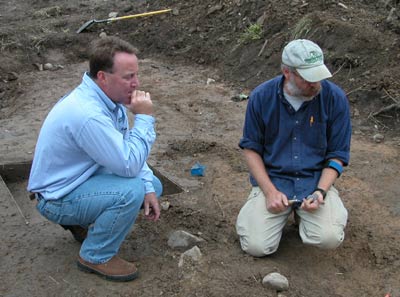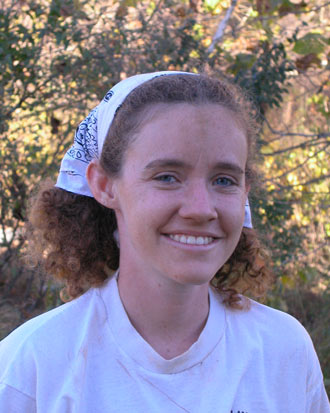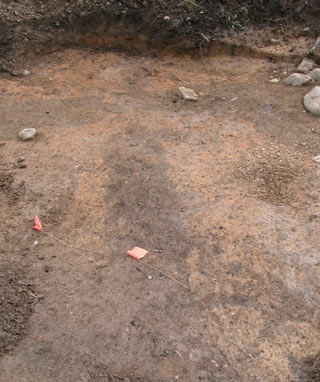Special Edition Daily Report October 14, 2004
_____________________________________________________________________________________
The Fort Edwards Archaeologist
Unearthing the Story of Joseph Edwards's Home and Fort
_____________________________________________________________________________________
Report on the Archaeological Excavations at Fort Edwards, home site of Joseph
Edwards and a French and Indian War frontier fort of Col. George Washington.
 This second major archaeological excavation is part of the ongoing project of The Fort Edwards Foundation of Capon Bridge, West Virginia, to preserve, protect and interpret the home site and fort site at Joseph Edwards's land grant on the banks of the Cacapon River in Hampshire County, West Virginia. This site represents both an early settler's home of the second quarter of the eighteenth century and a French and Indian War fort in Col. George Washington's chain of forts protecting the Virginia frontier. The excavation is under the direction of Dr. Stephen McBride of McBride Preservation Services of Lexington, KY. This report provided by The Foundation.
This second major archaeological excavation is part of the ongoing project of The Fort Edwards Foundation of Capon Bridge, West Virginia, to preserve, protect and interpret the home site and fort site at Joseph Edwards's land grant on the banks of the Cacapon River in Hampshire County, West Virginia. This site represents both an early settler's home of the second quarter of the eighteenth century and a French and Indian War fort in Col. George Washington's chain of forts protecting the Virginia frontier. The excavation is under the direction of Dr. Stephen McBride of McBride Preservation Services of Lexington, KY. This report provided by The Foundation.
___________________________________________________________________________________
Daily Report, October 14, 2004

As in the previous days, we continue to explore the interrelationship between the stockade wall with bastion, the cellar features and adjacent features. The photo above has been edited to help you see the various features. In the lower left corner is the bastion jutting out from the stockade wall that enters the picture on the far left. There is a small curved feature inside the bastion that has always puzzled us. The bastion then runs into one of the cellar features (pile of rocks). The wall then continues beyond the stones and heads toward the right edge of the photo. Eventually the stockade is disturbed by a shallow feature (near the archaeologist in the blue coat) but probably continues on into the bank that we have not excavated. How far it continues we do not yet know. Along the edge of the excavation are several features shown in the photo below.
 This photo shows the edge of the excavation with several features running from top to bottom. The stockade wall with pronounced post molds is coming in from the left. The features from top to bottom appear to be stains rather than walls. David is cleaning out a small pit that is exposing a section of the junction of the deep stockade wall and a shallow feature that we have outlined in red dots. We will see a closeup of that section pit later. The feature behind him has two protrusions that make it hard to determine the features purpose. Only the stockade wall feature that is relatively deep and has distinct post molds is obvious to us. All the others just add to the puzzle. This photo shows the edge of the excavation with several features running from top to bottom. The stockade wall with pronounced post molds is coming in from the left. The features from top to bottom appear to be stains rather than walls. David is cleaning out a small pit that is exposing a section of the junction of the deep stockade wall and a shallow feature that we have outlined in red dots. We will see a closeup of that section pit later. The feature behind him has two protrusions that make it hard to determine the features purpose. Only the stockade wall feature that is relatively deep and has distinct post molds is obvious to us. All the others just add to the puzzle.
|

In the line of features shown in the series of photos above are two discontinuous lines. The could be unrelated features or they could be some type of line (wall, drain trench, drip line) that, for some reason, is interrupted by something. Another puzzle.

Today we had a visitor who has been a part of The Fort Edwards Foundation since it was founded. Our Secretary, Dave Pancake, came to puzzle along with Steve McBride. We know Dave loves forts; does he love puzzles as much? |

Here Dave and his son, Isaac, are looking at the strange feature with the two protrusions; it is outlined in red dots in this picture. |

We continued to search in the area of the spring for some evidence of a stockade. We recalled how Col. Washington reminded his men of the importance of securing the water source for the fort. We found a segment of stockade wall, but again there was a bit of a puzzle. It did not run in the direction that we had expected. Still more work will be required to answer this puzzle. |
Mapping the Features
 
As we continue to extend our excavation pits and uncover more features, we must continue to map their exact location. Kurt is shown using the Total Station survey instrument and Ann is holding the target that she places on several point around each feature.
Willing Worker of the Day
 |
Myrisa K. Byrd is one of the archaeological team who came to work on our dig. Myrisa graduated from the University of Kentucky and is now a kind of freelance archaeologist working for several companies whenever they are in need of field workers. She also works as a prehistoric lithic expert advising other archaeologists on stone points and implements. We appreciate her work at Fort Edwards and bid her farewell. Today is her last day since she has other commitments to go to. |
|
Artifact of the Day
 
Again today we found the kind of artifact we have been hoping for. As the team scraped the stockade feature adjacent to the cellar features they unearthed a musket ball the caliber used in the Brown Bess military musket. Can you see the ball just below the orange flag lying in the dark stockade trench stain?

We also found in another stockade feature near the spring an English gun flint and some pieces of a clay pipe. These also are of the era we expect for the fort. The term "English flint" does not mean it was made by the British; it means it is from flint mined in Great Britain as opposed to the type of flint found across the Channel in France.
Answer to a Mystery Artifact: Do you remember the mystery artifact of October 8th? Did you ever figure out what it is? Click here for the answer.
|
|
Faunal Expert

Every archaeology team should have a faunal expert, someone trained in recognizing animal bones. Our team has such an expert; she is Heidi shown here studying a deer bone found nearby. Fortunately, it is not an artifact; it is a fresh bone.
|
|












